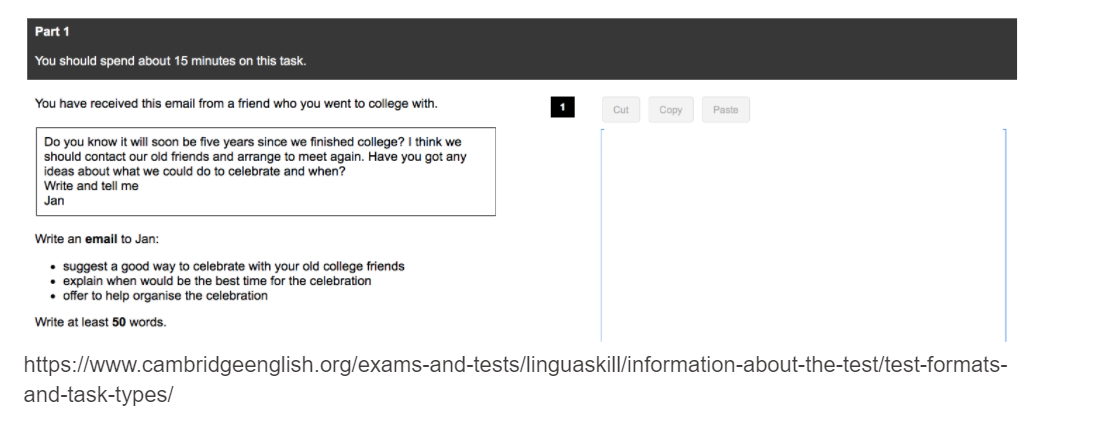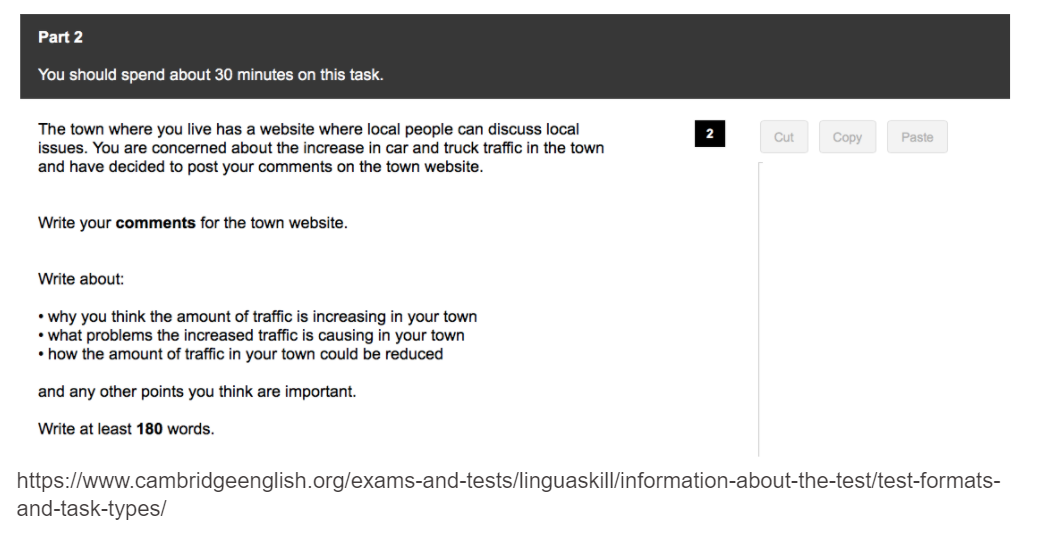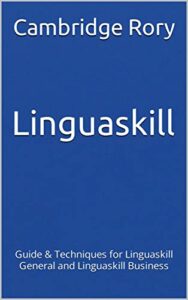Table of Contents
Linguaskill Writing
Ahh, writing. Tricky old writing. Is it easier than speaking because at least you have time to think? Write a comment below and let me know.
While you do have time to think, you still need to spend your minutes wisely in the Linguaskill writing section.
Linguaskill Writing Marking Criteria
Sorry, this section is for Linguaskill members only.
Linguaskill Writing Format
If you've seen my Linguaskill page, you'll remember that we need to answer 2 writing questions in this section of the exam. The first part (an email) is shorter (only 15 minutes) and you only need to write 50+ words. Whereas, it's recommended to spend about 30 minutes on the part 2 task and to write at least 180 words. Despite this difference, both tasks are worth 50% of the writing grade...don't ask me why :/ So both should be of equal importance.
Writing Part 1: 'Email'
Email Format:
The email task looks like this:

Email Technique:
In the exam, after reading the entire exercise, follow the steps below to get to your answer:
1. First identify your target reader. So, for example, in this case you will be writing to a colleague/friend, which means that you can use informal language. The target reader tells us what type of language to use. If you’re writing to your boss, you should use formal writing. So ALWAYS identify the person who will be reading your e-mail and adapt your type of writing accordingly: formal or informal. You should ask the agent delivering the exam, whether or not you can use draft (scrap) paper to make notes. If so, write "target reader: friend" or whoever the target reader is!
2. After you know the formality of the email, pay extra attention to the bullet point topics that you need to answer in the email. Before even starting to write, give short answers to each topic you need to answer. Write you short answers on the draft (scrap) paper. In this case, the first point requires you to ‘suggest a good way to celebrate with your old college friends’. So, think of a good way to celebrate and write it quickly on the draft paper. Do this for each topic. You don’t have to write a lot of detail on your draft paper, however, I recommend you think of an idea that you will be able to write about in a comprehensive way. As the bullet points are generally on the same theme, having an idea you can easily write about should help you to answer all aspects of the question. It should also help you get higher marks for length, idea development and vocabulary which are three things that the automarker looks for.
3. On the draft paper, you should also write a couple of words or a sentence showing how you will link between the topics. This will help you structure your answer and get higher marks for cohesion. Here is an example:
"Going on a pub crawl in the town where we went to college (this is a classic British pastime). Alcoholic drinking = better for weekend. Complicated to get all friends there so I'll help organise the best time.
In the example above we can see:
Suggestion: a pub crawl.
Link to second topic: alcoholic drinking --> the weekend.
Link to third topic: many people = complicated --> organise.
4. After you have your answer structured, get ready to write your email. Before starting, think of the email formality you identified again. This will be useful to think about at this stage as it will indicate how you should greet the person you are writing to.
5. Following the greetings comes the body of the email. Here go back to the structure you already have on your draft paper and follow that structure. Always make sure you cover all the topics.
6. At the end, adjust your goodbye to the formality of the email you are writing.
Extra Linguaskill Email Tips:
- Before the exam, practise planning answers for 3-4 minutes, using the structure above. The practise writing your emails in 8-9 minutes. Can you write 50 words in 8 or 9 minutes? Time yourself, just like in the exam. Finally, try to save 2-4 minutes at the end to read over your work. Pay particular attention to your spelling, capitalisations and punctuation as the automarker notices these!
- Practise using a variety of grammar structures in your writings, this will help you get higher marks with the automarker.
- I have some examples of longer, more comprehensive B2 and C1 level emails on my B2 First and C1 Advanced email pages. These will give you some useful pointers, vocabulary and grammar structures that you could use in your Linguaskill email!
Writing Part 2: 'Various'
Writing Part 2 (Various): Format:
In Linguaskill General, part 2 of the writing paper may ask you to write a web post, an article, a review, or something else.
In Linguaskill Business, part 2 of the writing paper will normally be aimed at a manager, staff or a client outside the company.
Here is what the question looks like:

As we can see, it looks very similar to the first question.
Writing Part 2 (Various) Technique:
- In this part the first thing you have to do is identify the type of writing you need to produce. In the example above, it is a web post.
- When you know the type of writing, you should identify who your target reader will be. Write this down on your draft paper. The web post above is targeted at other members of the community. For this, we can write in the first person, but I think it's okay to use fairly informal language.
- After this, and just like in the exercise before, pay extra attention to the topics that you need to answer. Before even starting to write, write answers to each topic you need to answer. Also write how you will connect the topics. So, in the case above, the first point requires you to state ‘why you think traffic is increasing’. So our draft paper might end up looking like this:
Target reader: community members
Language: slightly informal
Why more traffic: poor roads along other routes
Link to second topic: slower moving traffic and more accidents
Link to third topic: reduce the danger by pressuring the local government to give more money to road maintenance elsewhere.
4. Now we can start our writing, and just like before, remember to think who we are writing to and the level of formality to use. Focus on this in the greeting at the beginning and throughout.
5. In the body of our writing, you want to tick the automarker's boxes. So, remember, the automarker looks for:
- idea development (this should be covered through good planning at the beginning of the task). Using linking words and other cohesive devices throughout your writing will also help with this. You can learn more about language, formalities, cohesive devices and much more in my B2 First writing course and my C1 Advanced writing course. Although those courses are not specifically targeted at the Linguaskill exam, I'm sure your writing knowledge will improve a lot as a result of going through the pages and reading other students' writings with feedback!
- a variety and accuracy of vocabulary and grammar. You can send me a writing to mark and I will give you feedback via my Cambridge writing assessment service >>
- spelling, punctuation and capitalisation (this should be helped through thorough checking of your writing during the last few minutes of the task time)
6. Close your writing with an appropriate level of formality and save yourself time to read over your work!
Extra Linguaskill Writing Part 2 (Various) Tip
- Practising with various writings beforehand will help you know how long it takes you to plan, write and check your work. These 3 components are key to getting good marks in this part of the exam. My suggestion is, 4-5 minutes to plan, 22-24 minutes to write and 2-3 minutes to check your work at the end.
Linguaskill Writing Conclusion
Well, I hope you enjoyed this page.
As I said, check out my FCE and CAE writing courses (links above) and write some comments below if you have any questions.
Feel free to have a read of my Linguaskill book:
And remember: "failing to plan = planning to fail"


4 thoughts on “Linguaskill Writing”
Thank you very much. This helps me a lot for my preparation of this test.
My pleasure.
Thank you, It is so useful and easy to understand!
You’re welcome!